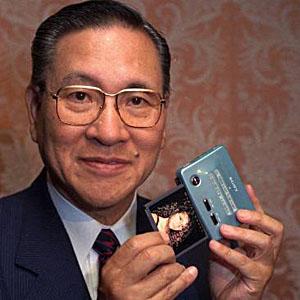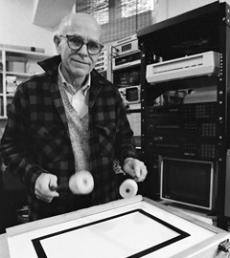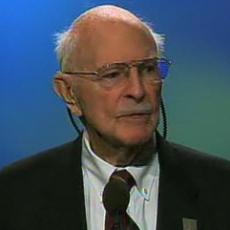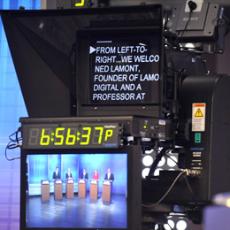
STEVE EMBER: I'm Steve Ember.
BARBARA KLEIN: And I'm Barbara Klein with the VOA Special English program EXPLORATIONS. Today we tell about three inventors who died last month. Max Mathews, Norio Ohga, and Hubert Schlafly all had a big influence on modern sound and communication technologies.
(MUSIC: Max Mathews playing "Daisy Bell," sound courtesy of David Merrill)
STEVE EMBER: Max Vernon Mathews has been called the father of computer music. He created electronic tools so that people could use computers as musical instruments. He had a huge influence on the development of electronic music and how it is written, recorded and played.
In 1957, Max Mathews wrote the first computer program that enabled a computer to create sound and play it back. At the time, he was working as an engineer at Bell Laboratories in New Jersey. His computer program was called Music. It enabled a large IBM computer to play a 17 second piece of music that he had written.

The computer was so slow it would have taken an hour to play the piece of music in 17 seconds. For that reason, Mathews moved the work to a tape player, which could be sped up to play the music at a normal speed. He later said that the sound quality of the musical notes was not great, but the technical importance of the music was huge.
BARBARA KLEIN: The science fiction writer Arthur C. Clarke visited Bell Laboratories in the 1960s. He heard a computer "sing" the song "Daisy Bell" on devices and programs developed by Max Mathews and other engineers. Clarke noted this technology in his book "2001: A Space Odyssey," which was later made into a movie.
Mathews continued creating other versions of the Music program. He became interested in how computers could help musicians outside recording studios. The Groove program he developed was the first computer program made for live performances.
He also developed an electronic device he called the Radio Baton. The device looks like two drum sticks. It enables the user to control the speed and sound levels of orchestral music playing on a computer. The user does this by moving the two sticks on a special electronic surface.
STEVE EMBER: Max Mathews had a long and productive career. He worked with composers like John Cage and Edgard Varese. He helped to create a center for research in computer music in Paris. And he taught at the Stanford University Center for Computer Research in Music and Acoustics in California.
Mathews told Wired.com that he believed modern musicians are not making full use of the power of computer music. He said a violin always sounds like a violin. But with a computer, the way a violin sounds is unlimited. He said he did not want computer sounds to replace live music. But he said he hoped laptop computers would one day be considered serious instruments.
(MUSIC: Beethoven's Ninth Symphony)
BARBARA KLEIN: That was a recording of Ludwig van Beethoven's Ninth Symphony. This work had a surprising influence on the technology of recorded music.
Sony Corporation official Norio Ohga helped to develop the compact disc in the late 1970s. He strongly pushed for CDs to be larger, and with a longer playing time. He wanted them to hold 75 minutes of music so that they could store all of Beethoven's Ninth Symphony on one disc. This way, listeners could enjoy the musical work without any break.
STEVE EMBER: Norio Ohga was born in Japan in 1930. He grew up playing the piano and taking singing lessons. He studied music at the Tokyo National University of Fine Arts and Music. His aim was to become an opera singer.
As a young man, Ohga reportedly owned a tape recorder that did not work well. He sent a letter detailing the problems to the manufacturer. The owners of the company were struck by his knowledge about music and technology. They asked him to serve as a part-time advisor.
The company later became known as Sony. In 1959, Ohga began working full-time with Sony.
BARBARA KLEIN: He worked in the Sony design department and influenced the look of the company's electronic products. He also worked on advertising campaigns and what kinds of products it developed.
Sony and Philips, another electronics manufacturer, worked together to create a new storage device for digital sound -- the compact disc. The new technology had its critics. But Ohga and others believed that the excellent sound quality of the CD would make it popular. Sony began producing CD recordings in 1982. The compact disc changed the electronics industry and the way people listened to music.
STEVE EMBER: Norio Ohga served as president of Sony, starting in 1982, and chief executive officer starting seven years later. He once said that leading a company was like leading an orchestra. He said a business leader had to work to build on the talents of the people in an organization, just like a director must work to bring out the best in members of an orchestra.
Under his leadership, Sony expanded into music and movies. He believed that a company that made electronic devices should also make products to use with the electronics.
Howard Stringer is the current head of Sony. He said that Norio Ohga helped make the company an entertainment leader by pushing the company to make electronics as well as music, movies and video games.
(MUSIC)

BARBARA KLEIN: Hubert Joseph Schlafly was an electrical engineer who helped change the way actors, politicians and other people speak on television. In 1950, he and two other men developed the teleprompter. One co-worker, Fred Barton, was an actor. He had an idea for a tool that would help television actors read their lines without having to memorize them. The other coworker was Irving Kahn. He worked as vice-president of radio and television at 20th Century Fox.
The first teleprompter involved a person who turned a long piece of paper printed with tall letters. As the actor read the lines, another person would move the paper ahead on the device. The teleprompter was first used on a television program called "The First Hundred Years." Later versions used television screens to show the words that were to be read.
Hub Schlafly and his coworkers believed that many companies would want to buy the teleprompter. So, they left their jobs and created the TelePrompTer Corporation to sell their invention.

STEVE EMBER: In 1952, former President Herbert Hoover became the first politician to use a teleprompter. The former president was speaking to delegates at the Republican National Convention in Chicago. For a brief time, he stopped reading and began to talk about a subject not written in his speech. When Hoover wanted to continue the speech, the words on the teleprompter were not moving. So he called out for the device to restart. Many reporters wrote about that incident, creating a new level of publicity for the teleprompter.
The teleprompter soon became popular with politicians who could use it to face the television camera while reading prepared statements, instead of looking down at their notes. Soon, the devices were used for almost all live television broadcasts.
BARBARA KLEIN: The TelePrompTer Corporation also worked on developing new television and cable technologies. By 1970, it was the country's largest cable company.
Hub Schlafly worked with Hughes Aircraft to develop video broadcasts using microwave transmission. He also helped organize the first use of a satellite to carry television broadcasts. Schlafly left the TelePrompTer Corporation in the 1970s. But he continued working to support the development of satellite television.
STEVE EMBER: In 2008, Schlafly became a member of the Cable Television Hall of Fame.
HUBERT SCHLAFLY: "It's a great honor to be included as one of the recipients of the 2008 Cable Television Hall of Fame."
(Sound courtesy of The Cable Center, Denver Colorado)
STEVE EMBER: During his acceptance speech, Schlafly announced that this award ceremony marked another special event. It was the first time he had ever spoken in public with the help of a teleprompter.
(MUSIC)
BARBARA KLEIN: This program was written and produced by Dana Demange. I'm Barbara Klein.
STEVE EMBER: And I'm Steve Ember. You can read and listen to our programs and get podcasts at voaspecialenglish.com. Join us again next week for another EXPLORATIONS program on the Voice of America.
teleprompter: a device used in television and moviemaking to project a speaker's script out of sight of the audience 電子提詞器
Classical music, as defined by reinvention
From Bhangra to Reggae, a musical trip around the world
Sony's 'father of CDs' dies at 81
(來(lái)源:VOA 編輯:崔旭燕)
